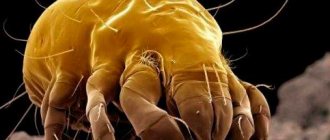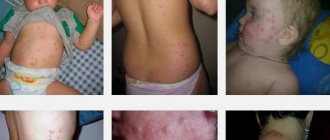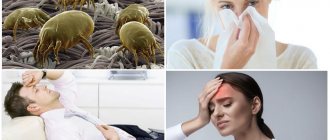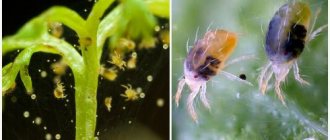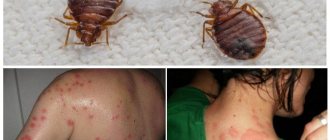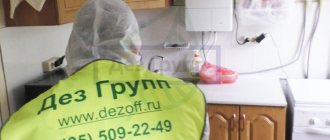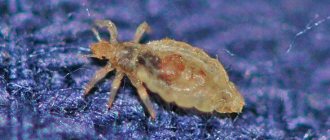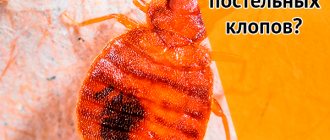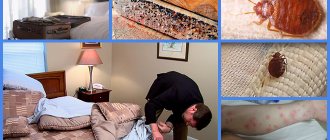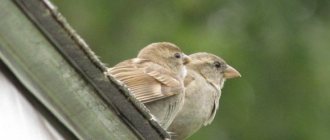Dusty, or bed mites - domestic parasites belonging to the arthropod family. Their habitat is dust, and their food source is dead human skin cells. Bed mites are unpretentious and can survive in almost any conditions. The most favorable environment for their living is warm and humid, the temperature is about 21 degrees Celsius, that is, the one that is installed in living quarters, and there is an abundance of food (epithelium). This explains their wide distribution.
Such parasites can cause allergies, and prolonged exposure to them can lead to the development of sinusitis and even asthma. In addition, the scabies mite provokes a disease such as scabies, which occurs with regular contact with its waste products.
That is why it is important to know what a tick that lives at home looks like and how to get rid of it.
You may be confusing dust mites with bed bugs or marks on your skin with bed bug bites.
Main types of house ticks
House ticks are a separate biological group of parasites that live in the residential environment. They not only spoil food, clothing and furniture, but also affect the health of humans and animals.
The following types of ticks can appear and reproduce in the living environment:
- Hairy house tick . This pest lives in flour, grain, plant and animal residues, and even in cheese and tobacco. Such mites actively develop at a temperature of 23-25 degrees and a relative air humidity of 80-90%. They can cause dermatitis in humans;
- Scabies mite (itching) . It develops and parasitizes only on humans in high humidity and warmth. It is the causative agent of scabies;
- Rat mite . The parasite primarily attacks rats, but, in the absence of a natural host, can attack other mammals, as well as humans. Rat mites cause a difficult to treat disease - rat mite dermatitis. This parasite is common in rural areas and poses a danger to its inhabitants;
- Chicken mite . This type of parasite is widespread throughout the world. Mainly lives in nests and droppings of birds, cracks of wooden surfaces. Can parasitize on the surface of human skin, causing skin rashes and irritations;
- Bird mite . This tick parasitizes wild and domestic birds, that is, it lives in close proximity to humans and is capable of attacking them.
Household ticks are dangerous not only because of their bites, but also because of the impact of their own feces on humans and pets.
Effective methods for treating bites
The body of many people responds adequately to bed tick bites, and they heal on their own within a few days. There are people when they need to provide emergency assistance, since their body reacts very specifically. In cases where atypical reactions occur, it is necessary to:
- Thoroughly wash the bite areas with soap or soda solution, after which they are rinsed with clean running water. To prepare the solution, you need to take a glass of water and add to it a tablespoon of soda or liquid soap.
- Bite areas should be disinfected with any alcohol-containing product, such as vodka or moonshine, cologne or perfume.
- Severe itching indicates an allergic reaction. To reduce these symptoms, you can use both pharmaceutical and folk remedies.
There are a number of effective and proven recipes. For example:
- Bite areas should be wiped with pure vinegar. There is no need to rinse off the product.
- You can apply a piece of ice or some product from the freezer to the bite site.
- If you apply a used bag of black or green tea to the site of the bite, this will relieve the victim of discomfort.
- Lotions are also made based on medicinal herbs. St. John's wort is considered the most effective remedy. To prepare the solution, you need to take a tablespoon of St. John's wort and pour a glass of boiling water. After the infusion has cooled, a cotton pad is soaked in the infusion and applied to the wound for half an hour. Herbs such as chamomile or calendula are suitable. The product is prepared in the same way as using St. John's wort.
- Treatment with a composition based on aloe and plantain. After mixing the ingredients, the wound is treated several times a day. The juices of these plants help reduce swelling of the bite site, reduce itching and have an antibacterial effect.
- Onion and garlic juice combined together act on the bite site in a similar way. The smell of onions and garlic, in addition to relieving discomfort, helps repel these bloodsuckers.
- You should drink at least 5 tablets of activated carbon to remove toxins from the body as quickly as possible.
As a rule, folk remedies help a person cope with negative consequences in the initial stages. If these remedies do not cope with the task, then you should use pharmaceutical remedies. Alternatively, you can use essential oils, which have the same effect as herbal infusions.
- Lemon.
- Orange.
- Lavender.
- Geranium.
- Tea tree.
- Needles.
- Juniper.
- Cypress.
- Sagebrush.
- Mint.
There are both special remedies developed for the bites of various insects, and non-special ones, but which cope with this task. The thing is that each body reacts differently to bed tick bites.
As a rule, the following pharmaceutical products are used:
- Special ointments “Fenistil” and “Rescuer”. These remedies have a wide spectrum of action and help relieve the victim of negative consequences.
- Vietnamese star, which is characterized by the manifestation of an antibacterial effect.
- Afloderm helps to cope with severe itching.
- Propolis tincture is effective against any bites.
- Afloderm ointment is used with Tavegil, which helps relieve the symptoms of allergic reactions.
- The “Tsindol” talker will easily cope with the task.
- Akriderm perfectly relieves signs of inflammatory processes.
What a dust mite looks like - photo under a microscope
Dust mites are invisible to the naked eye because they are only 0.5 mm long. It is possible to study the details of the structure of his body only with the help of a microscope.
One gram of house dust can contain from hundreds to thousands of parasites. It is known that their numbers increase significantly from August to October, especially after the start of the heating season.
A tick of this species, like all arachnids, has a flattened body, consisting of individual segments connected to each other. The linen mite moves with eight legs. Each limb has suction cups, thanks to which the harmful microorganism is firmly attached to surfaces. With the help of two pairs of jaws, the parasite captures and grinds food, and also pierces the skin of the host, as some mistakenly believe.
The body of dust mites is covered with a kind of water-repellent layer. If you examine the parasite using a microscope, you can come to the conclusion that it looks like an ordinary small spider. About 150 species of mites are known to live in house dust.
Habitat
The favorite places for dust mites to appear and accumulate are any “deposits” of dust. These can be bookshelves, old books, children's soft toys, baseboards, carpets, old shoes and other “dust collectors”.
Dust mites also love wool blankets, carpets, upholstery, carpeting and other fleecy surfaces. Pillows are generally a “nest” of dust mites.
It is almost impossible to get rid of parasites here; it is better to replace the pillow, especially with feather or down filling.
Today, more than 150 species of mites live in the dust of apartments and houses.
REFERENCE! There are from 100 to 1000 mites per 1 g of dust; the population varies depending on the time of year. The end of summer - the beginning of autumn is the peak of the number of dust mites in houses and apartments.
Where do dust mites start and live?
Most often, dust mites are concentrated in dusty environments that are difficult to clean, as well as in bedding. They can be found:
- In a pillow filled with natural bird feathers;
- In the mattress, especially if it is old and has not been cleaned for a long time. It is claimed that such mattresses consist of 10% mites;
- In a blanket that is stuffed with cotton wool;
- In a carpet made from natural materials, the pile of which can also be eaten by parasites;
- In bed linen;
- In furniture upholstery;
- In curtains and drapes;
- On bookshelves that are rarely dusted;
- In a bag located in the vacuum cleaner;
- In soft toys made from natural materials;
- In stale old clothes;
- In woolen blankets.
According to the Federal Budgetary Institution “Center for Hygienic Education of the Population” of Rospotrebnadzor, one gram of dust contains from 10 to 10,000 dust mites. In addition to them, about 350 thousand colonies of bacteria and about 100 thousand clusters of fungi live on bed linen.
The waste products of sofa mites, which cause allergic reactions, enter the air, slowly settle on the surface and gradually accumulate. Allergens get not only onto furniture and things, but also onto human skin and even into the respiratory tract.
Professional fighting methods
If you are going to call a disinfection specialist so that he can treat your apartment against bed mites in one session, then this procedure will only take a few hours. However, you won’t be able to stay in the treated room for about a few days, and then you will need to wash everything in hot water and wash it, so ventilate it. Specialists can be called from the FBUZ - Center for Hygiene and Epidemiology.
The cost of treating a 1-room apartment with domestic professional preparations using a hot or cold fog generator will be about 800 rubles, with a guarantee for 12 months - 1200 rubles, with a guarantee for 12 months and using imported odorless insecticides - 2000 rubles . These methods allow the cloud of the drug to remain in the air for several hours, penetrating into all microscopic cracks, cracks, etc. filling everything around, so the fog covers a large amount of area, destroying parasites.
How do bed ticks bite? Do they bite?
Many people are concerned about whether mattress mites bite and, accordingly, what the bite looks like. This type of parasite does not bite and does not spread infection. This is due to the fact that the pests are too small and cannot bite through human skin.
The cushion mite causes harm in a different way, through its metabolic products. These include:
- Cuticle remaining after molting;
- Secretions produced by parasites;
- Feces that contain proteins that cause allergic reactions.
Those who are predisposed to allergies should be especially careful, because the parasite causes extremely unpleasant symptoms that can develop into a serious illness. That is why, if alarming signs are detected, it is worth contacting an allergist or immunologist to check for suspected tick allergies.
The rash that appears on the skin in response to the activity of the mite is confused by some with bed bug bites. In fact, bed bugs, unlike ticks, leave very specific bites: they are numerous and grouped, looking like large swellings with a pronounced red seal in the middle.
Subcutaneous mite
It is necessary to consider the types of subcutaneous mites as another pest that can coexist unnoticed with humans. By analogy with dust, subcutaneous dust cannot be noticed independently. You can only guess the possibility of its presence based on persistent skin problems, including rashes, dermatitis and allergies. Among the factors contributing to the appearance of demodicosis are stressful situations. Where do subcutaneous mites come from:
- Impaired functioning of the digestive system;
- Malfunctions of the endocrine system;
- Low activity of the immune system;
- Incorrect diet;
- Improper daily hygiene.
Thus, anyone can become a victim of demodicosis. The pest's favorite habitat is the face, and much less often the shoulders or back. If you suspect the presence of a subcutaneous mite, you should immediately contact a dermatologist and take the appropriate tests. On an individual basis, the doctor will select the optimal treatment program and help you get rid of the irritant that is preventing you from leading a full life in the shortest possible time.
What causes mites to appear in bed?
Why is the bed most often attacked by dust mites? How do they get here?
The fact is that in every home, despite diligently maintaining cleanliness, there is a small population of these parasites. With frequent cleaning, washing and cleanliness of linen, replacing the filling in feather pillows with a more modern one, the number of mites is kept within the acceptable range: they are not enough to become a source of allergies.
If wet cleaning of premises and changing of bed linen is carried out rarely, a large number of keratinized skin particles accumulate in the layer of dust and on the fabric of bedding, on which clothes mites feed. Thus, favorable conditions are created for their nutrition, development and reproduction.
You should be especially careful: bed mites are often observed in rented apartments and rooms in inexpensive hotels, where guests often change and bed linen is not properly processed.
What it is?
Definition
House ticks belong to the type of sinatropic mites, that is, they are closely related to humans and their homes, just like mice, cockroaches, bed bugs, etc. At this time, microbiologists have established that there are more than 150 species of these parasites . And more than 10 species can cause an allergic reaction in humans.
The size of these parasites is so small that it is impossible to see them without a microscope. But their number in our house is huge - up to a thousand in just 1 g of dust, and up to hundreds of millions on our bed.
The peculiarity of dust mites is that they cause allergies. Feels good in carpets, feather pillows, mattresses, sofas, bed linen, etc.
All this is located approximately 1 meter from the floor and, when it enters the body, it provokes allergies. If the concentration of dust mites exceeds the norm, asthma may occur.
The dust mite feeds on dead skin particles , which a person loses, as is known, every day, in the amount of 1.5 - 2 g.
The mites themselves leave behind traces - feces, which destroy human skin and are very dangerous because they cause severe allergies.
REFERENCE! Each tick releases up to 20 fecal pellets per day. That is, only 1 mite produces 200% more waste than its own weight!
German scientists from the University of Munich have long proven that in children who live in villages and suburbs, allergies are much less common due to early contact with pets than in residents of cities and large cities who live in relatively sterile conditions, far from living things. nature.
How do they look?
Dust mites belong to the family of arachnids of the arthropod class. Very small, no more than 0.5 mm in size. Not noticeable to the naked eye, they are dangerous to humans and cause asthma and other allergic reactions.
Dust parasites live only 2-3 months, but how much harm and real danger each of them brings! The female can lay 50–60 eggs at a time.
Dust mites thrive in damp rooms, in apartments with high humidity and musty air. They like to live at temperatures from 19 to 25 °C, with air humidity above 55 - 60%.
What dust mites look like and how to recognize them is discussed here.
Existing types
Dust mites are conventionally divided into three types:
- Pyroglyphid (dermatophagoid: for example d farinae and d pteronyssinus) and some representatives of granary mites that appear from house dust.
- Predators are mites that feed on pyroglyphid mites.
- Random ticks brought in from outside and not reproducing in the apartment.
Remedies and methods for getting rid of bed mites
None of the existing methods guarantees the complete elimination of the feather mite population, but by taking the necessary measures, it is quite possible to reduce its population to a safe level. Under such conditions, you can be sure that parasites will not cause allergies.
How to get rid of bed dust mites? There are several types of means with which you can control their vital activity.
Chemicals, preparations and suspensions, the composition of which makes it possible to exterminate ticks. At the same time, they are completely safe for humans, for example:
- Allergoff spray , which not only has a detrimental effect on pests, but also neutralizes their waste products containing allergens;
- Easy Air is an organic product in the form of a spray. Suitable for processing various surfaces. Helps eliminate allergy symptoms caused by parasites;
- Milbiol aerosol is a bed mite treatment intended for treating mattresses and textile surfaces. The active substances of the drug act directly on ticks, disrupting their ability to feed and stopping their development and growth;
- Dani Earth is a spray from a Japanese manufacturer. Suitable for cleaning upholstered furniture, toys, pillows. It has a non-sticky texture, so it dries quickly;
- Digital . The preparation for treating premises is highly concentrated and toxic, so it should be used only in diluted form and only in personal protective equipment;
- All-Rug . This is a shampoo for cleaning carpets and washing floors, preventing the development of domestic parasites.
It is possible to independently prepare a product for treating places where a lot of dust and things accumulate. To do this, you need to prepare a saline solution, observing the following proportions: liter of water per 200g. salt. This composition will help fight household ticks.
If ticks appear in the house, then, in addition to treating the premises with chemicals, it is important to regularly ventilate and carry out wet cleaning. If there are allergy sufferers in the family, it is advisable to purchase a vacuum cleaner with an aqua filter: a regular vacuum cleaner not only does not neutralize allergens, but also contributes to the spraying of mite particles and their excrement. A household steamer can destroy dust mites by exposing them to hot steam. Make it a habit to steam the mattress, blanket and pillow on both sides when changing a set of bed linen, this will prevent the appearance of parasites. After this procedure, the laundry needs to be thoroughly dried.
What are they afraid of?
Dust mites are afraid of:
- direct sun;
- frosty air;
- wind;
- hot iron;
- any heat treatment, etc.
Most ticks live in the bed, so it is advisable to dry all bedding and ventilate it in the sun or in the cold, depending on the time of year.
Once a month, it is advisable to wash the floors with a salt solution : 300g per small bucket. When wiping dust, it is better to use a special dust removal liquid. After washing, it is better to iron the bed linen.
Allergic reaction to bed dust mites
Dust mites are a source of severe allergic reactions. They affect the mucous membrane of the respiratory tract and cause:
- Conjunctivitis, rhinitis, allergic dermatitis;
- Respiratory allergosis;
- Rhinoconjunctivitis;
- Quincke's edema;
- Bronchial asthma.
In medicine, such a reaction to household parasites is called tick-borne sensitization .
The occurrence of an allergy caused by bed mites is indicated by such signs as frequent sneezing, wheezing in the chest, suffocating cough, lacrimation, and red eyes.
This disease is diagnosed based on data collection, blood tests and microbiological studies.
Allergy to dust mites is treated by limiting the patient's contact with allergens, using medications, and desensitization. These are measures aimed at reducing the body's perception of allergens. For these purposes, an allergen extract is administered to a person, gradually increasing the dosage and concentration. With the help of desensitization, the allergic person’s body does not react so strongly to the source of irritation.
External signs of a bite
Detecting uninvited guests is not so easy due to their microscopic size. The parasite cannot bite a person, since its jaws are weak and not designed for this. When interacting with arthropods, a person experiences an allergic reaction. Irritation is a response to contact with mite feces.
Not everyone knows the signs of bed mites, so people may confuse them with other pests. The characteristic “bites” are a bit similar to mosquito bites - multiple red bumps appear on the victim’s skin. The rashes always follow a path at a distance from each other. The affected areas are very itchy.
Main symptoms of contact with ticks:
- rash;
- cough and runny nose without ARVI or acute respiratory infections;
- redness of the eyelids, inflammation of the mucous membrane of the eye, tearing;
- sometimes difficulty breathing and fever.
In rare cases, bed mites lead to a severe allergic reaction and angioedema, which can be fatal. Before you start treating irritation, you need to start removing parasites.
More about the parasite
One of the human companions, the linen or bed mite, lives for several hundred years and is distributed in all parts of the world. He feels comfortable with a person. It feeds on dead skin cells, dandruff, lost hair, hides in the folds of dirty bed linen, in pillows, blankets, mattresses and feels great in a dusty room that has not been cleaned for a long time.
Note! A person does not notice the presence of a bed mite if he has good immunity and does not know what an allergic reaction is.
Sensitive people have it more difficult. Their skin and respiratory organs respond to pest bites with endless runny nose, coughing, sneezing, and skin irritations in the form of a small red rash.
It is possible to examine a bed mite (it is a type of saprophyte) only with the help of a microscope, it is so small.
A tick (as we see it in photographs) looks like this:
- yellow-brown;
- the body is flattened, covered with chitin;
- length – from 0.2 to 0.6 mm;
- six limbs with suction cups;
- head in the shape of a triangle.
An adult tick lives for a month and a half, during which time the female lays more than three hundred eggs.
Effective measures to combat linen lice
Given the specific lifestyle of linen lice, they need to be dealt with somewhat differently than with dust mites. First of all, you should wash all clothes at maximum temperature, especially underwear, and not only what the person is wearing, but also what is stored in closets. Before washing, items can be treated with special aerosols, for example, A-Par.
On a note
You can also freeze clothes outside in winter or heat them inside a car left in the sun in summer.
Secondly, you need to treat the lice on the body and hair. With a certain probability, a person who has allowed body lice to multiply may also be infected with head and pubic lice. To combat them, a variety of pediculicidal agents are used, widely available in pharmacies:
- Lice sprays (Pedikulen-Ultra, Para-Plus, Paranit, Nyuda);
- Shampoos (Parasidosis, Pedilin, Hygia);
- Creams (Nix, Nittifor);
- Combs that allow you to comb out lice and nits without treating your hair with chemicals;
- Ointments that allow treatment of lice pubis (mainly based on benzyl benzoate).
It is better not to use folk remedies - kerosene, turpentine, alcohol, vinegar, as if handled incorrectly they can be dangerous and cause severe chemical burns to the skin.
For maximum reliability, you should also wash all bedding - sheets, pillowcases, duvet covers.
For more tips on getting rid of linen lice, read this article.
If all these procedures are carried out carefully, then there will be no lice or nits left on your underwear or body.
Prevention
To avoid turning your home into a habitat for a colony of parasites, you must adhere to a few simple rules:
- do not enter living quarters in street clothes and, especially, do not sit on the bed in them and, if possible, wash them immediately;
- do wet cleaning daily and regularly clean with a vacuum cleaner, not forgetting hard-to-reach places where dust accumulates;
- regularly clean curtains, bedspreads and carpets, and, if possible, abandon textile products or replace them with synthetic ones;
- regular treatment of floors and furniture surfaces with disinfectants;
- frequent steaming of bedspreads, upholstery, soft toys;
- regular washing and combing of pets, daily removal of hair from the floor and furniture;
- in winter, carpets, pillows and blankets can be taken out onto the balcony or outside.
Sub-zero temperatures are no less destructive for pests than heat.
The use of such simple methods can not only reduce the number of linen mites, but also prevent the formation of other harmful parasites.
Prevention and timely destruction of household pests is much more effective and simpler than treating the consequences of the appearance of parasites in the house, therefore it is recommended that regular sanitary treatment of rooms, timely dry cleaning of textile surfaces and treatment of bed mattresses and pillows will significantly reduce the threat of diseases that can be caused by insects.
It is necessary to be attentive to the regular change of bed linen, in which parasites most often appear.
Fighting bedbugs
Bed bugs are the hardest to deal with. This is primarily due to the fact that they can hide indoors in almost any place, even in places where people are not aware of the presence of parasites.
Secondly, it is difficult to get rid of bedbugs using thermal and mechanical methods - freezing out an entire apartment is difficult to do without the risk of damage to communications, and heating the room to high temperatures is possible only with the use of specialized equipment (moreover, this procedure is long and involves the risk of deformation of plastic interior elements from high temperatures). temperature). It will also not be possible to mechanically crush or vacuum all the parasites if the room is heavily infested.
You can quickly and effectively destroy bedbugs using insecticides. All places where bedbugs can hide and move are treated with such means. Sometimes you have to dismantle sofas, tear down baseboards and lift up parquet floors. If this is not done, then some of the parasites will survive, and even if persecution gives any result, it will be only temporary.
For more information about exterminating bedbugs in an apartment, see a separate article on this topic: Getting rid of bedbugs in an apartment quickly and effectively.
Also, do not forget about preventive measures, because if all neighbors have bedbugs, then over time the parasites can again enter the apartment.
Visual video: dust mites crawling in a pillow...
Description, causes of infection
These parasites belong to the arachnids, have very small body sizes, which greatly complicates their detection; they grow up to a maximum of .5 mm. In addition, their body has a very light color and is almost transparent. These ticks, unlike other species, do not feed on the blood of animals and people; their body structure is developed completely differently and is adapted for biting, so in this regard they are absolutely harmless. But the danger is still present, since in the process of life they secrete a protein that can cause quite acute allergic reactions in humans. You can see what feather mites look like in the photo.
The main and main reason why these parasites appear is unsanitary conditions. The threat is that they multiply very quickly and after a short period of time huge colonies appear. It will not be possible to destroy them completely, but it is possible to reduce their numbers to a minimum. They are often called bed, pillow, household, dust, and all because of their habitat.
If we talk about their natural habitat, they parasitize birds, namely their feathers. In apartments and houses, they choose upholstered furniture, carpets, mattresses and other textiles for living. They choose hard-to-reach places where dust accumulates. But most often they live precisely in pillows and feather beds, in which they find the most favorable conditions.
Allergy as the main symptom
Linen mite bites are nothing more than the body’s reaction to parasite excrement. Because the symptoms intensify after sleep, the question arises: do ticks bite at night? Pests do not bite, but close contact with them provokes an allergic reaction of varying severity.
On a note!
Some people experience weakness, headache, and fatigue after sleeping in an infected bed. Others note rhinitis or the presence of a dry cough without other signs of a cold. Those with sensitive skin or people prone to allergies notice rashes on different parts of the body.
External signs of allergy to bed mites: rashes, redness, swelling, itching. No different from the symptoms of an allergic reaction of another etymology. However, in the case of bed mites, treatment does not give the desired result, the allergy becomes chronic, since the unfavorable factor continues to act - excrement. The condition improves only after the destruction of the parasite colony.
